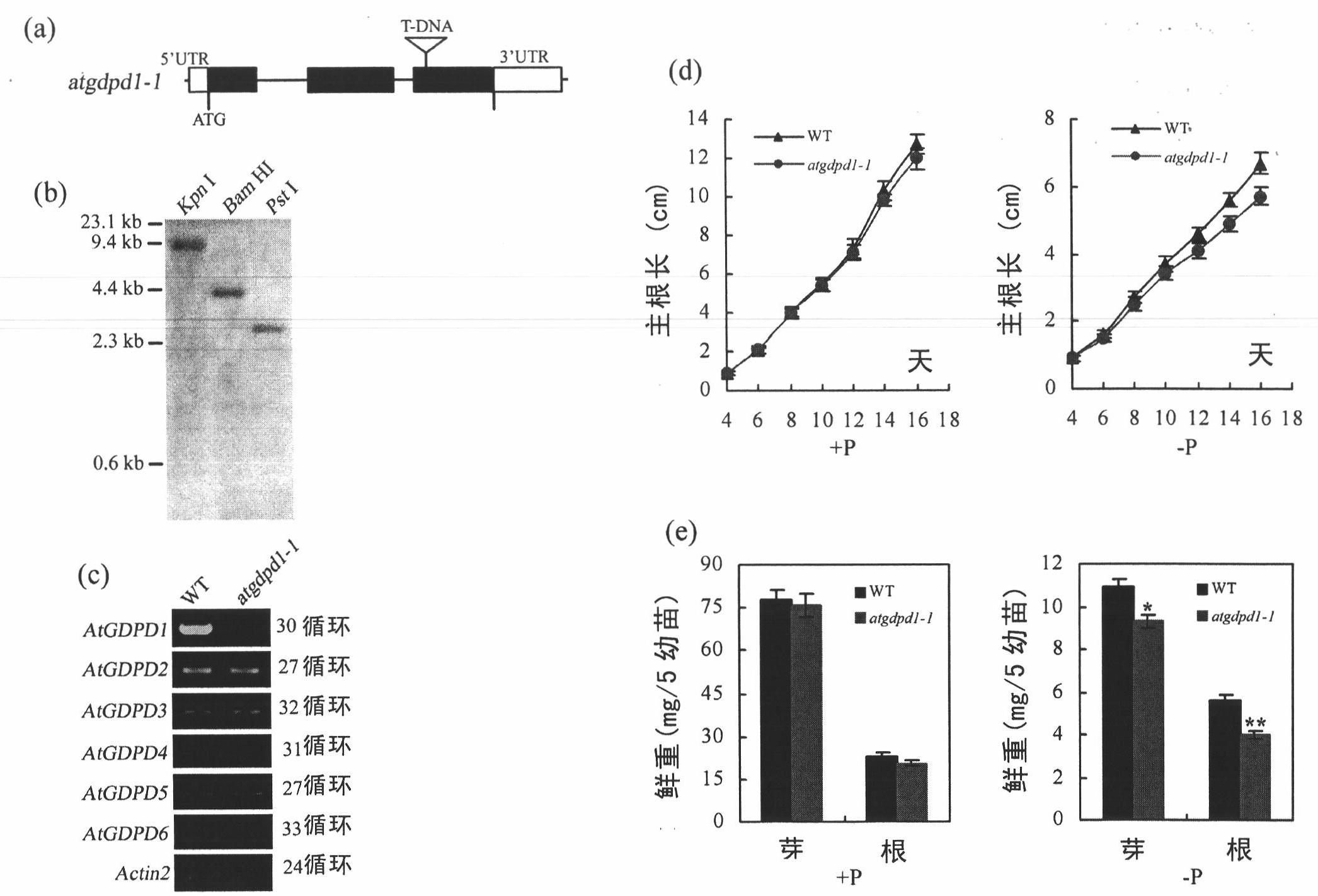Low-phosphorus resistant gene and application thereof
A low-phosphorus and environmental-resistant technology, applied in the fields of biotechnology and botany, can solve the problems that plants cannot be directly used, water eutrophication and ecological environment pollution, and aggravate the depletion of phosphate rock resources.
- Summary
- Abstract
- Description
- Claims
- Application Information
AI Technical Summary
Problems solved by technology
Method used
Image
Examples
Embodiment 1
[0165] Embodiment 1, the gene and protein sequence of AtGDPD1
[0166] Genomic DNA extraction
[0167] (1) Take an appropriate amount of plant (Arabidopsis thaliana, Col-0) tissue and place it in a 1.5ml centrifuge tube, add 50 μl of extract (0.2M Tris-HCl, pH 9.0, 0.4M LiCl, 25mM EDTA, 1% (v / v) SDS), after grinding into a slurry with a grinding rod, add 350 μl of extracting solution to rinse the grinding rod.
[0168] (2) Add 400 μl of phenol / chloroform (1:1), shake vigorously, centrifuge at 12000 rpm for 15 minutes, and take the supernatant.
[0169] (3) Add 400 μl of chloroform, shake vigorously, centrifuge at 12000 rpm for 15 minutes, and take the supernatant.
[0170] (4) Add 500 μl of isopropanol, mix well, let stand for 10 minutes, centrifuge at 12000 rpm for 10 minutes, and discard the supernatant.
[0171] (5) Wash the precipitate once with 70% (v / v) ethanol, and centrifuge at 12000 rpm for 5 min.
[0172] (6) Discard the supernatant, blow dry, and add 20-50 μl of...
Embodiment 2
[0208] Example 2, AtGDPD1 tissue expression characteristics
[0209] The extraction, reverse transcription and PCR amplification of total RNA were the same as in Example 1.
[0210] The Northern blot method is the same as described in the literature Huang, J.R., Takano, T. and Akita, S. (2000) Expression of a-expansin genes in young seedlings of rice (oryza sativa L.). Planta, 211, 467-473.
[0211] GUS detection
[0212] The method is the same as described in the literature Jefferson, R.A., Kavanagh, T.A. and Bevan, M.W. (1987) GUSfusions: β-glucuronidase as a sensitive and versatile gene fusion marker in higherplants. EMBO J.6, 3901-3907.
[0213] E. coli transformation
[0214] Escherichia coli competent cells TOP10 were purchased from Invitrogen. Transform Escherichia coli using the heat shock method, mix the plasmid with melted competent cells, place on ice for 30 minutes, heat shock in a water bath at 42°C for 45 seconds, and place on ice for 2 minutes. Add 400 μl of...
Embodiment 3
[0223] Example 3, AtGDPD1 expression is induced by low phosphorus nutrient growth environment
[0224] The inventors detected by Northern blot analysis and found that the expression of AtGDPD1 gene was strongly induced by the low-phosphorus nutrient growth environment, and as the stress time of the low-phosphorus growth environment prolongs, the expression of AtGDPD1 gene also gradually increased ( figure 2 a). This suggests that AtGDPD1 is involved in the growth of plants adapting to low phosphorus nutrient environment.
[0225] In order to further understand the molecular mechanism of the AtGDPD1 gene's response to the low-phosphorus growth environment, the inventors detected whether the promoter of the AtGDPD1 gene responded to the low-phosphorus growth environment. The result is as figure 2 As shown in b, the activity of the AtGDPD1 gene promoter was obviously induced by the low phosphorus environment. Compared with the wild type, the expression level of GUS in the who...
PUM
 Login to View More
Login to View More Abstract
Description
Claims
Application Information
 Login to View More
Login to View More - R&D
- Intellectual Property
- Life Sciences
- Materials
- Tech Scout
- Unparalleled Data Quality
- Higher Quality Content
- 60% Fewer Hallucinations
Browse by: Latest US Patents, China's latest patents, Technical Efficacy Thesaurus, Application Domain, Technology Topic, Popular Technical Reports.
© 2025 PatSnap. All rights reserved.Legal|Privacy policy|Modern Slavery Act Transparency Statement|Sitemap|About US| Contact US: help@patsnap.com



